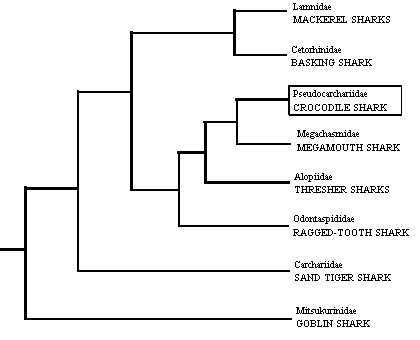Family Pseudocarchariidae:
Crocodile Shark — 1 species

- eyes exceptionally large
- gill openings extend onto the top of the head
- body spindle-shaped
- pectoral, dorsal, pelvic, and anal fins relatively small
- tail stalk with precaudal pits and low lateral keels
- caudal fin asymmetrical, with a relatively long lower lobe
- jaws highly protrusible
- teeth prominent, with long cusps
- coastal to oceanic; scattered localities, subtropical to tropical zones of Atlantic, Pacific, and Indian oceans

Crocodile Shark (Pseudocarcharias kamoharai)
For most of the time since its discovery in 1936, the little Crocodile Shark (Pseudocarcharias kamoharai) has been a taxonomic foster child, shuffled from genus to genus and family to family. It was originally described as Carcharias kamoharai by ichthyologist Kiyomatsu Matsubara, based on a 29-inch (73.5-centimetre) male specimen from the Koti Fish Market in Japan. Over the next four decades or so, the crocodile shark was variably placed in the genus Carcharias or Odontaspis and in the family Odontaspididae.
In 1973, systematist Leonard Compagno — based on his own extensive anatomical studies of this and related lamniform sharks — proposed a new genus and family to properly commemorate the Crocodile Shark's distinctiveness. Most ichthyologists adopted Compagno's proposal, and Pseudocarcharias kamoharai (family Pseudocarchariidae) has been the crocodile shark's formal designation ever since. In his 1990 synopsis of lamnoid systematics, Compagno regarded the crocodile shark as the primitive sister taxon to the meta-group formed by the Megamouth, thresher, Basking and mackerel sharks (families Megachasmidae, Alopiidae, Cetorhinidae, and Lamnidae).
Naylor et al.'s 1997 comparative study of mtDNA sequences of lamnoid sharks supports a close affinity between the Megamouth and Crocodile Sharks, suggesting they may be even more closely related than Compagno proposed. According to the molecular systematics data, Megamouth and the Crocodile shark are sister taxa (more closely related to one another than to any other group), sharing a relatively recent common ancestor. Naylor and his co-workers admit that the close relationship between Megamouth and the Crocodile Shark implied by the genetic data has little morphological support, but suggest that similar counts of intestinal partitions, dorsal fin shapes, and vertical migration habits may be synapomorphies (shared derived characters) useful for defining them as a cohesive group. The fossil record suggests that the Crocodile Shark is relatively recent compared with Megamouth. The earliest known representative of Pseudocarcharias are fossilized teeth from mid-Miocene deposits in northern Italy, about 15 million years old.
If further evidence comes to light supporting that the Megamouth and Crocodile Sharks are as closely related as the mtDNA evidence seems to suggest, both species may eventually be lumped under a single family. Since the family Pseudocarchariidae was established some 10 years before Megachasmidae, if these families are indeed fused, it seems likely that the former familial name will take priority over the latter.
More about the life history and behavior of the Crocodile Shark
